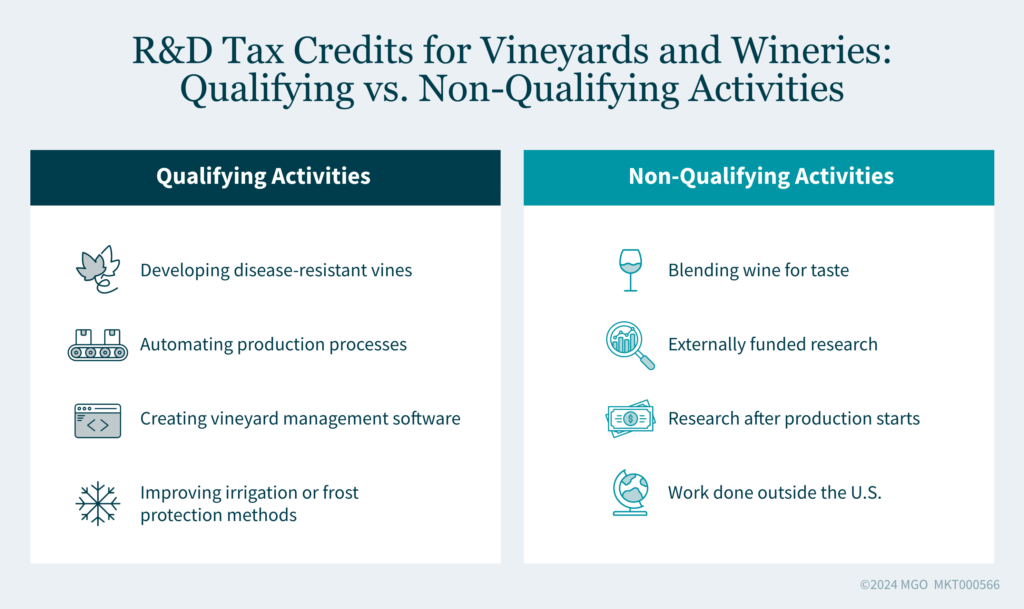Key Takeaways:
- Vineyards and wineries may qualify for the R&D tax credit if they develop new systems, automate processes, or experiment with sustainable agricultural practices.
- Claiming the credit can help businesses conserve cash for reinvestment.
- It’s crucial to document experimentation, material usage, and personnel involvement to support your claim.
—
The research and development (R&D) tax credit is designed to incentivize organizations to invest in innovation in the U.S. It does this by providing companies dollar-for-dollar cash savings for performing activities related to developing, designing, or improving products, processes, formulas, or software.
Vineyards and wineries often overlook the R&D tax credit — but claiming it can boost your business’s bottom line. This article explores the types of activities that might qualify and how to claim it while minimizing audit risks.
What Activities Qualify for the R&D Credit?
To qualify, activities must meet the IRS’s four-part test:
- Permitted purpose: The purpose of the activity must be to apply the information discovered to create or improve a product or process that is to be used internally or offered for commercial purposes.
- Elimination of uncertainty: There must be a clear goal to eliminate uncertainty about the design, methodology, or capability of developing or improving a product or process.
- Process of experimentation: The activity must involve a process of evaluating alternatives to achieving the desired outcome. Examples might include ongoing testing, simulation, modeling, or trial and error.
- Technological in nature: It must rely on principles of science, such as biology, chemistry, engineering, agricultural or food sciences, or computer sciences.
In the context of wineries and vineyards, qualifying activities might include:
- Viticultural innovation: Developing new trellis systems or grafting rootstock to create plants with faster maturation or better disease resistance. Techniques to optimize plant exposure to sunlight for higher-quality grape growth also qualify.
- Process automation: Experimenting with equipment to automate sorting, fermenting, and filtering wine.
- Software development: Developing new software to track vineyard history, grape varietals, and planting schedules.
- Sustainability and efficiency: Improving soil nutrient management, pest and disease control, and irrigation systems. For example, testing frost protection methods that also preserve moisture can meet the experimentation requirement.
Activities That Do NOT Qualify
While blending wine for taste is a critical part of winemaking, the IRS excludes activities solely aimed at improving taste due to its subjective nature. However, efforts to extend shelf life or improve functionality — such as filtration techniques or packaging trials — may qualify.
Other activities that automatically exclude a project from qualification include:
- Funded research
- Research conducted after the launch of commercial production
- Research conducted outside of the U.S.
- Research in economics, behavioral sciences, arts, and management

Why The R&D Credit Matters for Vineyards and Wineries
The wine industry is highly competitive, with thousands of wineries vying for consumer attention. R&D credits can help your business conserve cash that you can reinvest into operations, helping your business stay competitive.
For smaller operations, this incentive can be transformative. Like many growers and vintners, you may underestimate the scientific nature of your work, viewing it as traditional or routine. Yet agricultural and food sciences often underpin your practices.
Tips for Claiming the R&D Credit
To successfully claim the R&D credit, you need thorough documentation for your qualifying activities. Here are a few tips for maintaining the right documentation and reducing audit risks:
- Document every experiment: Keep detailed records, including project descriptions or plans, trial designs, test logs and reports, chemical analyses, notes, presentations, and emails.
- Track material consumption: If you use fruit or other components during testing, log these separately from production batches. Many wineries fail to track material consumption, particularly in the bottling stage.
- Identify eligible personnel: Consider employee roles, titles, and compensation. W-2 wages are simpler to claim, but payments to contractors can also qualify if appropriately documented.
- Separate personal preferences from science: Blending for taste and other subjective improvements does not qualify. Focus on activities that meet the technological nature and process of experimentation criteria. Clearly differentiate taste-testing activities from experiments focused on functionality or improvement.
How MGO Can Help
MGO’s Vineyard and Wineries team understands the nuances of claiming the R&D credit in this industry. Our advisors provide tailored strategies to identify qualifying activities, document experimentation, and prepare claims that can withstand IRS scrutiny.
Whether you’re developing innovative processes, testing new agricultural techniques, or implementing sustainable practices, we can help you capture the R&D credit to improve your cash flow.
Reach out to our team today to learn how MGO can help your vineyard or winery thrive through innovative tax strategies.